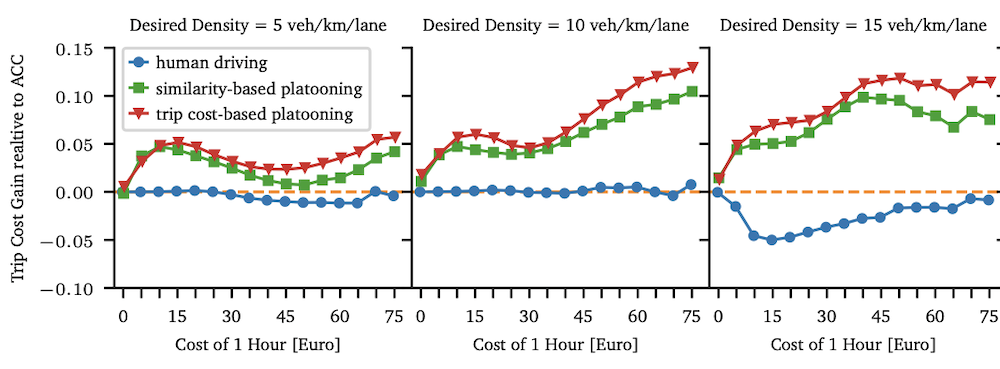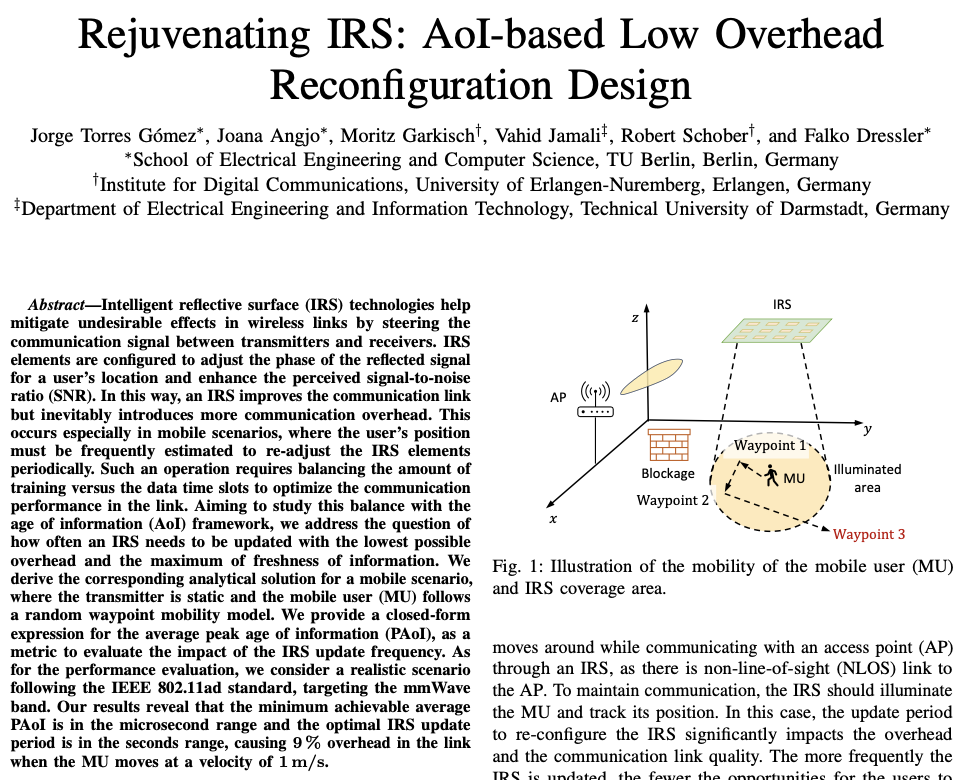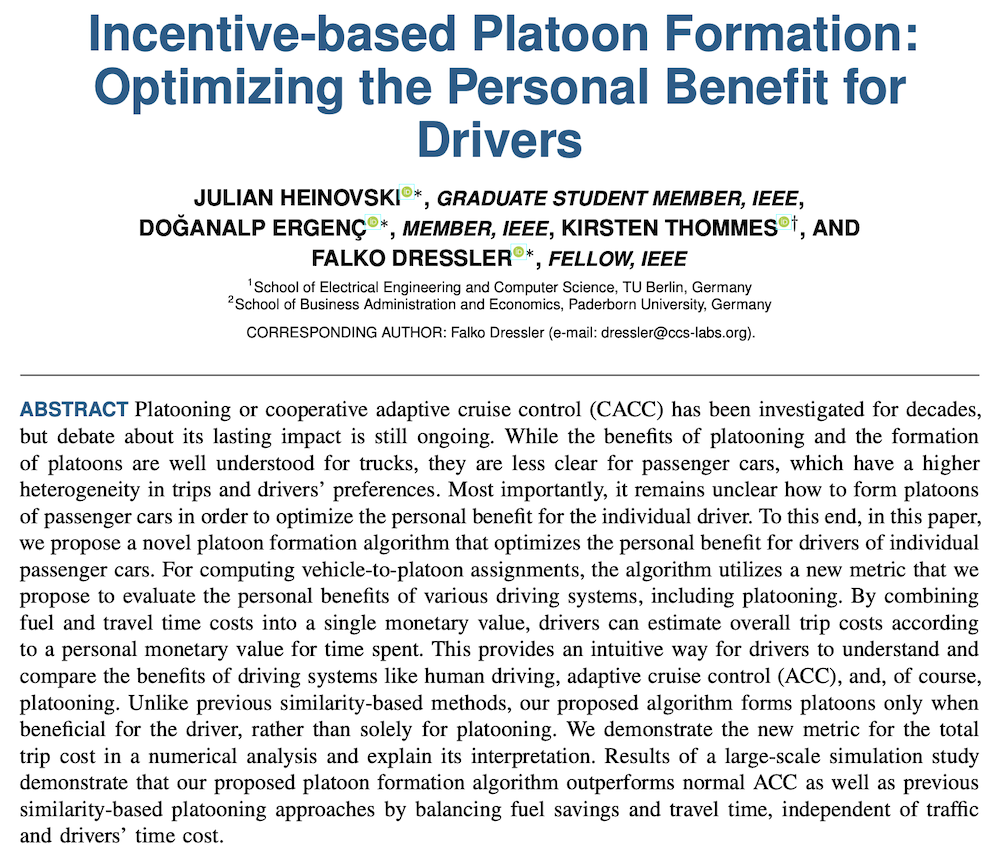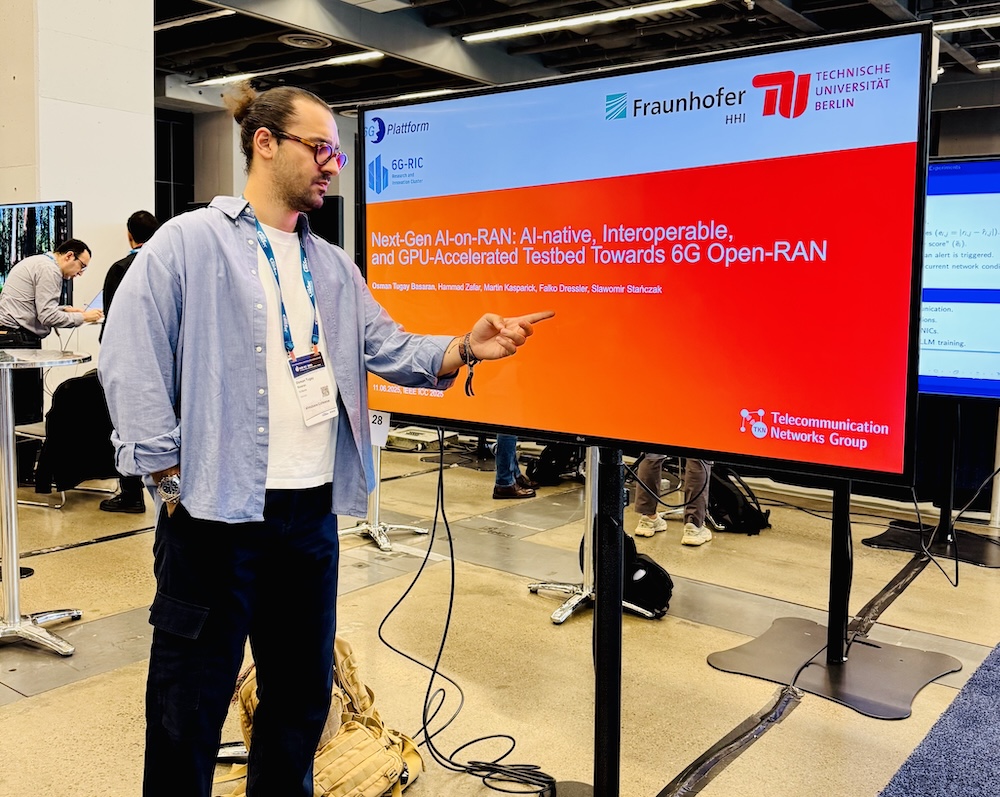Literature Database Entry
segata2016safe
Michele Segata, "Safe and Efficient Communication Protocols for Platooning Control," PhD Thesis, Institute of Computer Science, University of Innsbruck, February 2016. (Advisors: Falko Dressler and Renato Lo Cigno; Referees: Falko Dressler, Renato Lo Cigno and Claudio Ettore Casetti)
Abstract
Modern vehicles are becoming smarter and smarter thanks to the continuous development of new Advanced Driving Assistance Systems (ADAS). For example, some new commercial vehicles can detect pedestrians on the road and automatically come to a stop avoiding a collision. Some others can obtain information about traffic congestion through the cellular network and suggest the driver another route to save time. Nevertheless, drivers (and our society as well) are always striving for a safer, cleaner, and more efficient way of traveling and standard, non-cooperative ADAS might not be sufficient. For this reason the research community started to design a vehicular application called "platooning". Platooning simultaneously tackles safety and traffic congestion problems by cooperatively coordinating vehicles in an autonomous way. Traffic flow is optimized by using an advanced Adaptive Cruise Control (ACC), called Cooperative Adaptive Cruise Control (CACC), which drastically reduces inter-vehicle gaps. By being autonomously coordinated, platooning vehicles implicitly implement automated emergency braking, a fundamental application for freeway safety. The idea is to form optimized road trains of vehicles where the first drives the train, while the others autonomously follow at a close distance, without requiring the driver to steer, accelerate, or brake. Platooning can have an enormous impact on future transportation systems by increasing traffic flow (and thus reducing congestion), increasing safety, reducing CO2 emissions, and reducing the stress of driving. This application is extremely challenging due to its inter-disciplinary nature. Indeed, it involves control theory, vehicle dynamics, communication, and traffic engineering. In this thesis we are mostly concerned with the communication aspects of this application, which is fundamental for making the vehicles cooperate, improving the efficiency of the application with respect to a pure sensor-based solution. Application requirements are very tight and, given that the envisioned communication technology will be IEEE 802.11-based, there are concerns on whether these requirements can really be met. The focus of the thesis is in this direction. The first contribution is the design of PLEXE, an extension for the widely used vehicular simulation framework Veins that enables research studies on various platooning aspects, including design and evaluation of control algorithms, communication protocols, and applications. The tool is open source and free to download and use, and it realistically simulates both communication and vehicle dynamics. This makes PLEXE a valid testing platform before real world deployment. The second contribution is a set of undirected information broadcasting (beaconing) protocols that specifically take into account the requirements of the application. We initially develop four static (i.e., periodic) approaches and compare them against two state of the art dynamic protocols, showing that our approaches are capable of supporting the application even in heavily dense scenarios. Then, we propose a dynamic protocol that further improves the application (increasing safety) and the network layer (reducing resource usage) performance. The final contribution is a platooning control algorithm that, compared to state of the art approaches, is re-configurable at run-time and that can be adapted to network conditions. We thoroughly test the algorithm in highly challenging scenarios. These scenarios include a realistic network setup where the road is shared by human- and automated-driven vehicles. Human-driven vehicles interfere with automated-driven ones by sending data packets on the same channel. Moreover, we also consider a scenario with realistic vehicle dynamics, which takes into account vehicles' engine and braking characteristics. The algorithm is shown to be robust to network and external disturbances, to have a fast convergence, and to be very stable. The results in this work thus represent a big step towards the real world implementation of platooning systems.
Quick access
Authors' Version ![]() (PDF on this web site)
(PDF on this web site)
BibTeX ![]()
Contact
BibTeX reference
@phdthesis{segata2016safe,
author = {Segata, Michele},
title = {{Safe and Efficient Communication Protocols for Platooning Control}},
advisor = {Dressler, Falko and Lo Cigno, Renato},
institution = {Institute of Computer Science},
location = {Innsbruck, Austria},
month = {2},
referee = {Dressler, Falko and Lo Cigno, Renato and Casetti, Claudio Ettore},
school = {University of Innsbruck},
type = {PhD Thesis},
year = {2016},
}
Copyright notice
Links to final or draft versions of papers are presented here to ensure timely dissemination of scholarly and technical work. Copyright and all rights therein are retained by authors or by other copyright holders. All persons copying this information are expected to adhere to the terms and constraints invoked by each author's copyright. In most cases, these works may not be reposted or distributed for commercial purposes without the explicit permission of the copyright holder.
The following applies to all papers listed above that have IEEE copyrights: Personal use of this material is permitted. However, permission to reprint/republish this material for advertising or promotional purposes or for creating new collective works for resale or redistribution to servers or lists, or to reuse any copyrighted component of this work in other works must be obtained from the IEEE.
The following applies to all papers listed above that are in submission to IEEE conference/workshop proceedings or journals: This work has been submitted to the IEEE for possible publication. Copyright may be transferred without notice, after which this version may no longer be accessible.
The following applies to all papers listed above that have ACM copyrights: ACM COPYRIGHT NOTICE. Permission to make digital or hard copies of part or all of this work for personal or classroom use is granted without fee provided that copies are not made or distributed for profit or commercial advantage and that copies bear this notice and the full citation on the first page. Copyrights for components of this work owned by others than ACM must be honored. Abstracting with credit is permitted. To copy otherwise, to republish, to post on servers, or to redistribute to lists, requires prior specific permission and/or a fee. Request permissions from Publications Dept., ACM, Inc., fax +1 (212) 869-0481, or permissions@acm.org.
The following applies to all SpringerLink papers listed above that have Springer Science+Business Media copyrights: The original publication is available at www.springerlink.com.
This page was automatically generated using BibDB and bib2web.








